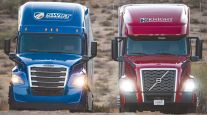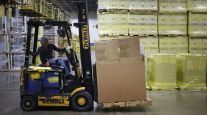Recent Surge in Orders for New Trucks Expected to Slow in 2011, Experts Say
This story appears in the Feb. 21 print edition of Transport Topics.
CORAL GABLES, Fla. — The recent surge in heavy-duty truck orders will slow as the buying focus shifts from better-capitalized large fleets to smaller carriers that may not be able to afford as much new equipment, industry experts said.
“People have gotten excited about the order intake, but don’t run to the bank yet,” James Hebe, Navistar International Corp. senior vice president, said last week. “The big fleets are placing their orders for 2011 and part of 2012. The pace of the last three months can’t be maintained.”
Mark Lampert, senior vice president of Daimler Trucks North America LLC, agreed, saying, “I don’t think the pace we have been seeing in the last three to four months is sustainable.”
They spoke at the BB&T Capital Markets Transportation Conference here.
“We are starting to see more small- and medium-sized fleets in the market,” Lampert said. “The largest eight or nine carriers were buying 300 to 500 trucks. Now it is closer to 10 or 15.”
New truck orders recently topped 27,000 a month, according to Americas Commercial Transportation Research Co., and half those orders came from just 35 fleets, Hebe said.
“There is a lot of pent-up demand to buy trucks” among smaller carriers, Hebe said. “Then [fleet owners] walk over to the bank and reality sets in. They want to buy 50, but the order is scaled back to five to 10 because of financing restrictions, he said.
Rising operating costs, such as fuel, also are having an effect.
“Some carriers may find the increased operating costs will eat them before they can buy trucks,” said BB&T Capital Markets analyst Thom Albrecht.
Kenny Vieth, president and senior analyst at ACT Research, said the slower pace of orders as the year unfolds is typical, and he foresees North American orders that could approach 20,000 units a month later this year, far above 2010 totals that hovered around 12,000 monthly.
Ed Pence, vice president and general manager for Cummins Inc.’s heavy-duty engine business, underscored the relative strength of the North American and Asian markets by noting that heavy truck purchases last year in China were about 1 million.
“The growth in Asia has been completely unprecedented,” Pence said. “We think there is some very exciting potential there.”
At the same time the order pace eases, manufacturers are facing a new threat in the form of higher materials costs and potential supply shortages of tires and key engine components, said executives from Navistar Inc. and Daimler Trucks North America.
“Tires have become an issue,” Lampert said. “Rubber trees only grow so fast. We feel the constraint is on the supply market. The supply constraint is absolutely out there now.”
“We will see constraints in tires and engine blocks,” Hebe said. “Suppliers now, especially Tier 2 and 3, come from all over the world. The certainty isn’t there now because you don’t know where the supplier is [based].”
Despite strains such as higher steel costs, Pence said, “We are doing everything we can to offset any cost increases.” He said Cummins doesn’t believe materials costs will change much this year.
Lampert and Hebe had a different view, suggesting that fleets could be staring at still another round of price increases for new tractors next year.
“We are under tremendous pressure, particularly on tires that are both increasing in price and are harder to obtain,” Lampert said.
He said increases for basic materials including steel and aluminum are heading for cost increases between $700 and $900 per tractor.
Asked about a price increase in 2012, Hebe said “absolutely,” citing increased raw materials costs. He didn’t say how much prices could rise, but noted the importance of materials costs by saying they comprise between 75% and 80% of a new tractor’s cost.
Hebe and Lampert also downplayed the potential for a return to peak sales years that topped 300,000 in the United States, saying that market was driven by tax incentives and emissions rules rather than demand for freight.
One sign of that, Hebe said, is that 2010 orders are heavily weighted toward replacement of aging equipment rather than adding capacity.
For example, Werner Enterprises plans to buy between 1,600 and 2,000 tractors this year, Chief Financial Officer John Steele said, while keeping the fleet size steady at 7,300 units.
However, Billy Hupp, chief operating officer of Estes Express Lines, said at the meeting that its anticipated purchase of 400 units would include 100 tractors to add to capacity.
Although orders and sales have recovered, Vieth said he was concerned about the lack of fleet additions if the U.S. economy grows at the 3% to 3.5% pace that economists anticipate, since that level of expansion will generate substantially more freight.
“If the economy grows at that pace, there is going to be a fairly meaningful capacity shortfall,” he said.




